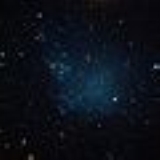
IC 1613
Encyclopedia
IC 1613 is an irregular
dwarf galaxy
in the constellation
Cetus
near the star 26 Ceti. It was discovered in 1906 by Max Wolf
, and is approaching Earth at 234 km/s.
IC 1613 is a member of our Local Group
. It has played an important role in the calibration of the Cepheid variable
period luminosity relation for estimating distances. Other than the Magellanic Clouds
, it is the only Local Group dwarf irregular galaxy where RR Lyrae-type variables have been observed.
In 1999, Cole et al. used the Hubble Space Telescope
to find that the dominant population of this galaxy has an age of ~7 Gyr. Using its Hess diagram
, they found that its evolutionary history may be similar to that of the Pegasus Dwarf Irregular Galaxy
. Both galaxies are classified as Ir V in the DDO system. Also in 1999, Antonello et al. found five cepheids of Population II in IC 1613, giving self-evident support for the existence of a very old stellar population component of IC 1613. In 1999, King, Modjaz, & Li discovered the first nova
ever detected in IC 1613.
Irregular galaxy
An irregular galaxy is a galaxy that does not have a distinct regular shape, like a spiral or an elliptical galaxy. The shape of an irregular galaxy is uncommon – they do not fall into any of the regular classes of the Hubble sequence, and they are often chaotic in appearance, with neither a...
dwarf galaxy
Dwarf galaxy
A dwarf galaxy is a small galaxy composed of up to several billion stars, a small number compared to our own Milky Way's 200-400 billion stars...
in the constellation
Constellation
In modern astronomy, a constellation is an internationally defined area of the celestial sphere. These areas are grouped around asterisms, patterns formed by prominent stars within apparent proximity to one another on Earth's night sky....
Cetus
Cetus
Cetus is a constellation. Its name refers to Cetus, a sea monster in Greek mythology, although it is often called 'the whale' today. Cetus is located in the region of the sky that contains other water-related constellations such as Aquarius, Pisces, and Eridanus.-Ecliptic:Although Cetus is not...
near the star 26 Ceti. It was discovered in 1906 by Max Wolf
Max Wolf
Maximilian Franz Joseph Cornelius Wolf was a German astronomer and a pioneer in the field of astrophotography...
, and is approaching Earth at 234 km/s.
IC 1613 is a member of our Local Group
Local Group
The Local Group is the group of galaxies that includes Earth's galaxy, the Milky Way. The group comprises more than 30 galaxies , with its gravitational center located somewhere between the Milky Way and the Andromeda Galaxy...
. It has played an important role in the calibration of the Cepheid variable
Cepheid variable
A Cepheid is a member of a class of very luminous variable stars. The strong direct relationship between a Cepheid variable's luminosity and pulsation period, secures for Cepheids their status as important standard candles for establishing the Galactic and extragalactic distance scales.Cepheid...
period luminosity relation for estimating distances. Other than the Magellanic Clouds
Magellanic Clouds
The two Magellanic Clouds are irregular dwarf galaxies visible in the southern hemisphere, which are members of our Local Group and are orbiting our Milky Way galaxy...
, it is the only Local Group dwarf irregular galaxy where RR Lyrae-type variables have been observed.
In 1999, Cole et al. used the Hubble Space Telescope
Hubble Space Telescope
The Hubble Space Telescope is a space telescope that was carried into orbit by a Space Shuttle in 1990 and remains in operation. A 2.4 meter aperture telescope in low Earth orbit, Hubble's four main instruments observe in the near ultraviolet, visible, and near infrared...
to find that the dominant population of this galaxy has an age of ~7 Gyr. Using its Hess diagram
Hess diagram
A Hess diagram plots the relative density of occurrence of stars at differing color-magnitude positions of the Hertzsprung-Russell diagram for a given galaxy. The diagram is named after R. Hess who originated it in 1924. Its use dates back to at least 1948....
, they found that its evolutionary history may be similar to that of the Pegasus Dwarf Irregular Galaxy
Pegasus Dwarf Irregular Galaxy
The Pegasus Dwarf Irregular Galaxy is an irregular galaxy and a dwarf galaxy in the direction of the constellation Pegasus. It was discovered by A.G. Wilson in the 1950s...
. Both galaxies are classified as Ir V in the DDO system. Also in 1999, Antonello et al. found five cepheids of Population II in IC 1613, giving self-evident support for the existence of a very old stellar population component of IC 1613. In 1999, King, Modjaz, & Li discovered the first nova
Nova
A nova is a cataclysmic nuclear explosion in a star caused by the accretion of hydrogen on to the surface of a white dwarf star, which ignites and starts nuclear fusion in a runaway manner...
ever detected in IC 1613.

